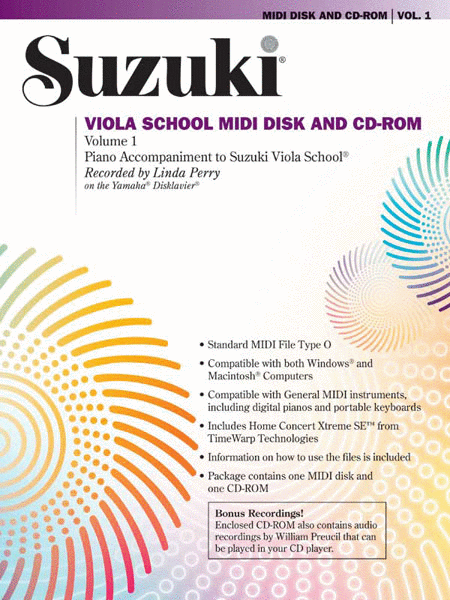Suzuki Viola School MIDI Disk Acc./CD-ROM, Volume 1
-
Ships in 1 to 2 weeks
Details
Description
SKU: AP.30610
Volume 1. Method/Instruction; String - Viola (Suzuki); Suzuki. Suzuki Viola School. CD-ROM/MIDI Disk. Alfred Music #00-30610. Published by Alfred Music (AP.30610).ISBN 9780739057629. UPC: 038081346021. English.
Teach viola with the popular Suzuki ViolaSchool. The Suzuki Method of Talent Education is based on Shinichi Suzuki's view that every child is born with ability, and that people are the product of their environment. According to Shinichi Suzuki, a world-renowned violinist and teacher, the greatest joy an adult can know comes from developing a child's potential so he/she can express all that is harmonious and best in human beings. Students are taught using the mother-tongue approach. Each series of books for a particular instrument in the Suzuki Method is considered a Suzuki music school, such as the Suzuki Viola School. Suzuki lessons are generally given in a private studio setting with additional group lessons. The student listens to the recordings and works with their Suzuki viola teacher to develop their potential as a musician and as a person.
This MIDI Disc and CD-ROM set is a great tool for Suzuki viola lessons. This enhanced CD-ROM of the Suzuki viola method, Volumes 1 and 2 contains all of the piano accompaniments plus an exclusive version of Home Concert which will show the music on a computer screen, while turning the pages for your students as they play. Also included on the CD are the listening tracks from the David Nadien / Koji Toyoda recordings accompanied on piano by Linda Perry.
Titles: Twinkle, Twinkle, Little Star Variations (Suzuki) * Lightly Row (Folk Song) * Song of the Wind (Folk Song) * Go Tell Aunt Rhody (Folk Song) * O Come, Little Children (Folk Song) * May Song (Folk Song) * Long, Long Ago (Bayly) * Allegro (Suzuki) * Perpetual Motion (Suzuki) * Allegretto (Suzuki) * Andantino (Suzuki) * Etude (Suzuki) * Minuet 1, Minuett III from Suite in G Minor for Klavier, BWV 822 (Bach) * Minuet 2, Minuet, BWV Anh. II 116 from Notebook for Anna Magdalena Bach (Bach) * Minuet 3, Minuet BWV Anh. II 114/Anh. III 183 (Bach) * The Happy Farmer from Album for the Young, Op. 68, No. 10 (Schumann) * Gavotte (Gos.
About Suzuki Method
The Suzuki Method is based on the principle that all children possess ability and that this ability can be developed and enhanced through a nurturing environment. All children learn to speak their own language with relative ease and if the same natural learning process is applied in teaching other skills, these can be acquired as successfully. Suzuki referred to the process as the Mother Tongue Method and to the whole system of pedagogy as Talent Education. The important elements of the Suzuki approach to instrumental teaching include the following:an early start (aged 3-4 is normal in most countries); the importance of listening to music; learning to play before learning to read; -the involvement of the parent; a nurturing and positive learning environment; a high standard of teaching by trained teachers; the importance of producing a good sound in a balanced and natural way; core repertoire, used by Suzuki students across the world; social interaction with other children. Suzuki students from all over the world can communicate through the language of music.

 Share
Share